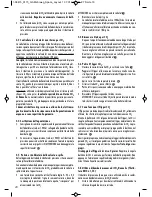
14
•
Secure the CO
2
long-term test in an upright position at a clearly
visible point in the aquarium where a gentle flow of water pre-
vails.
씎
•
Stick the “CO
2
” colour matching scale to the outside of the front
pane.
씏
Please note:
As the CO
2
takes some time to diffuse into the indica-
tor, the colouring of the indicator always takes 1-2 hours to respond
to changes in the CO
2
content. You should therefore always increase
the supply of CO
2
only in small steps of a few bubbles per minute
spread over several days until the ideal CO
2
content is attained.
4.3 Use as a long-term pH test
Provided that there are no other substances in the water which will
have a substantial influence on the pH level (e.g. humic acids, nitrate,
pH minus preparations), the CO
2
long term test can also be used to mo-
nitor the pH value in the aquarium.
For this purpose, you must:
•
Measure the carbonate hardness (CH) of the aquarium water
(tests available from specialist retailers).
•
Stick the appropriate “pH” colour matching scale to the outside
of the front pane.
쏹
The pH value of the aquarium water can now be read directly from the
colour scale.
Measure the carbonate hardness regularly and always use an appro-
priate colour scale.
4.4 Replacing the special CO
2
indicator
In order to guarantee the quickest and most exact colour response at
all times, we recommend filling the test container with fresh special CO
2
indicator every 4 to 6 weeks.
For this purpose, open the test container and pour the old indicator
down the drain. Rinse test container with tap water and dry with kit-
chen paper before refilling.
4.5 Cleaning the CO
2
long-term test container
Use warm water and a soft sponge. Do not use any cleaning agents.
If necessary, grease the two O-rings slightly with Vaseline before re-
assembling the test container. Do not use any other lubricants, as these
may lead to incorrect colour indications.
4.6 Special information
•
The special CO
2
indicator is harmless and does not contain any
chemical solvents. Prolonged skin contact and eye contact should
nevertheless be avoided.
•
Any indicator which may be dropped into the aquarium water by
mistake is harmless for the creatures living in the aquarium.
•
The indicator should be protected from sunlight, heat and frost.
Always keep ampoules protected from light during storage. The
filling level may vary for technical reasons.
4.7 If you’re keen to know more: How you can also calcu-
late the CO
2
content in the aquarium
Certain correlations apply between CO
2
content, carbonate hardness
(KH) and pH value. The CO
2
content in the water can be calculated
accurately on the basis of the pH value and carbonate hardness. Suit-
able pH and KH tests are available from specialist retailers.
•
Measure the carbonate hardness of your aquarium water.
•
Read the pH value which corresponds to the desired CO
2
content
from the table. You should set this pH value +/- 0.1 by adju-
sting the number of bubbles accordingly.
Example:
Carbonate hardness 4 °d, recommended CO
2
content
20 mg/l = recommended pH 6.8
5 Care and maintenance
5.1 Replace the CO
2
cylinder
•
Empty
cylinder: Close cylinder valve. Unscrew coupling ring
using 27 mm spanner and screw pressure reducer onto refilled
reusable CO
2
cylinder. Open cylinder valve The
bubble count
setting will be retained.
•
Full
cylinder: Close cylinder valve. Turn setting knob of pressure
reducer towards " + " as far as it will go, in order to release any
residual pressure in the pressure reducer (the solenoid valve must
be open for this purpose). Unscrew coupling ring using 27 mm
spanner and screw pressure reducer onto refilled reusable CO
2
cy-
linder. Open cylinder valve
Reset number of bubbles.
•
Always close the cylinder valve in order to shut down the CO
2
supply for a prolonged period. Unscrew the pressure reducer
when the cylinder is to remain out of use for a prolonged period.
5.2 Testing the CO
2
backflow check valve
The check valve protects your valuable pressure reducer from corro-
sion caused by back-flowing water. As dirt particles may collect on the
sealing surfaces over the course of time, the backflow check valve
should be checked at least once a year and replaced every 2-3 years
for safety's sake.
Tip:
Install a transparent test hose temporarily between backflow
check valve and pressure reducer/solenoid valve and shut down the
Too much CO
2
CO
2
correct
Not enough CO
2
pH value
KH 6.3 6.4 6.5 6.6 6.7 6.8 6.9 7.0 7.1 7.2 7.3 7.4 7.5
2
32
25
20
16
13
10
8
6
5
4
3
3
2
3
48
38
30
24
19
15
12 10
8
6
5
4
3
4
64
51
40
32
25
20
16 13
10
7
6
5
4
5
80
63
50
40
32
25
20 16
13
10
8
6
5
6
96
76
60
48
38
30
24 19
15
12
10
8
6
7
111 89
70
56
44
35
28 22
18
14
11
9
7
8
127 101 80
64
51
40
32 25
20
16
13
10
8
9
143 114 90
72
57
45
36 29
23
18
14
11
9
10
159 126 100 80
63
50
40 32
25
20
16
13
10
11
175 139 111 88
70
55
44 35
28
22
18
14
11
12
191 152 121 96
76
60
48 38
30
24
19
15
12
13
207 164 131 104 82
65
52 41
33
26
21
16
13
14
223 177 141 112 89
70
56 44
35
28
22
18
14
CO
2
content in mg/l
21
1-08415_0115_GA Mehrweg_Space_Layout 1 07.01.2015 11:27 Seite 13















































